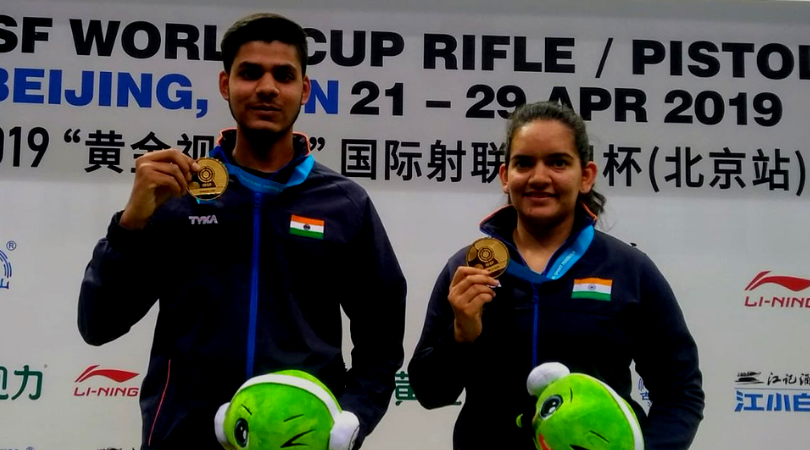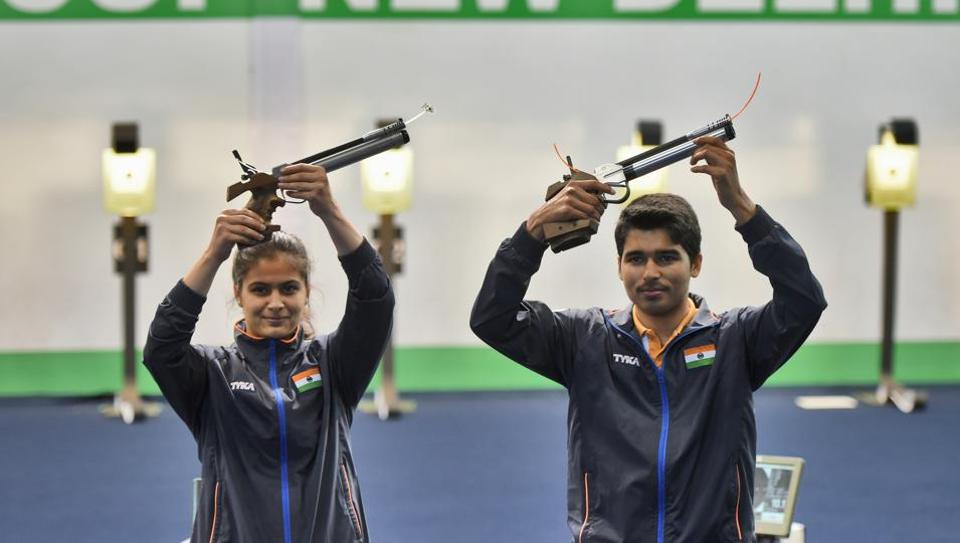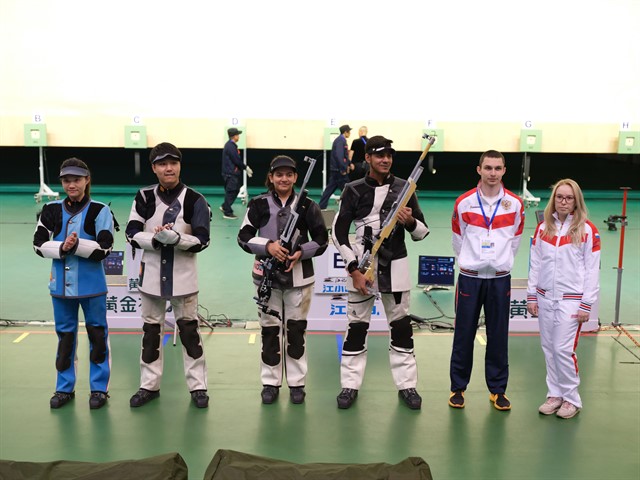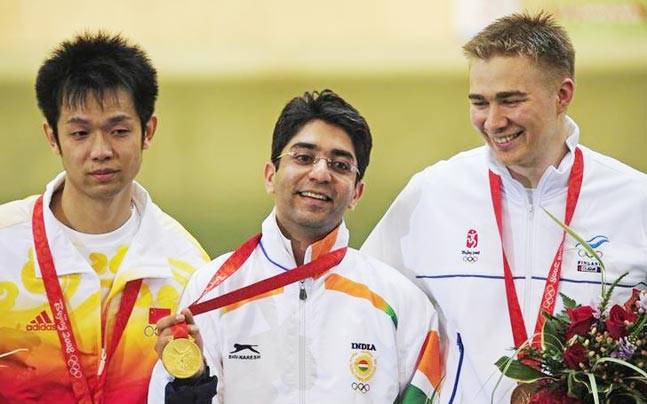Featured
Shooting unveils new rifle and pistol mixed team formats

Since it was announced in late 2016 that shooting will hold mixed team events at the Tokyo Olympics, the ISSF has tried various formats for them. The sticking point, in rifle and pistol events, has always been that the finals halls in shooting ranges across the world are designed to hold only 8 shooters. This is because all individual rifle/pistol events have 8 finalists, with the exception of the Men’s Rapid Fire Pistol which has 6 finalists (explained here and here). As every mixed team is composed of two shooters, that means the finals hall should be able to hold only 4 teams, which is too few considering that 3 of them will be medalling.
Early Formats
To get around the issue of hall size, the ISSF initially tried a semi-final format through most of 2017, by way of “test events” at World Cups. 8 teams would qualify for the semi-finals and would be divided into 2 groups of 4 teams each, depending on their qualification rankings. Then, the top team of each semi-final would advance straight through to the gold medal match whereas the 2nd placed team of each semi-final advanced to the bronze medal match, with the remaining teams being eliminated.
The ISSF even tinkered around with the formats of the medal matches themselves, trying a simple format where the team with the highest total score in the medal match won it, as well as a different match-play style format where 1 or 2 shots per shooter used to constitute a “set” and teams would get 2 match points for winning a set, similar to the format long adopted by recurve archery.
However, in the 2nd half of 2017, the ISSF decided that the semi-finals were not working. One of the possible reasons could be that they made the event too long (with the shooters requiring to shoot qualification, semi-final and a medal match). Featuring both semi-finals and both medal matches on television might have also been considered a lengthy endeavour, especially when accounting for the significant sighting and preparation time that has to be provided to every new shooter that comes to the firing line.
Another drawback was that the format would result in differing rest for the competing teams, if shot in sequential order. In particular, the team placing 2nd in the 2nd semi-final would have to right away shoot the bronze medal match whereas their opponents, i.e., the team placing 2nd in the 1st semi-final, would have had rest during the 2nd semi-final itself. Adding a rest period between the semi-finals and the medal matches would again result inissues from a broadcasting perspective. It should however be noted that while in most sports rest would always be a welcome thing, in shooting some shooters might prefer to shoot the medal match right after their semi-final with no rest as it would mean they are already in their shooting rhythm.
Format Adopted in late 2017
Eventually, a new format was adopted where the semi-finals were done away with and only 5 teams advanced directly to the final, a final which would have a format very similar to the individual events. Besides the fact that only 5 teams seems inadequate for a final where 3 of them would be winning medals, this also meant that the finals hall would have to accommodate 10 shooters instead of the usual 8. While this may not have been a major challenge in terms of feasibility, it resulted in the finals hall looking very crowded.
Another major issue with the 5-team final was that the eliminations started too late. In individual 10m rifle/pistol finals with 8 shooters each, every shooter shoots 2 series of 5 shots each before the single-shots and eliminations begin. However, in the team events, due to only 5 teams starting the final in the first place, there were 3 series of 5 shots each before the single shots and eliminations could begin. Further, while the individual events saw a total of 6 eliminations, undoubtedly the most exciting part of the final along with the last couple of shots that decide the gold medallist, the team events could showcase only 3 eliminations.
 Indian shooters reacted to the introduction of new rules by winning two gold medals in Beijing World Cup.
Indian shooters reacted to the introduction of new rules by winning two gold medals in Beijing World Cup. The initial series of 5 shots can sometimes be a little tedious and hard to follow for many spectators. All shooters are shooting at their own time simultaneously and it can become very difficult to tell who is shooting well and who is doing poorly. Many fans find these initial series similar to table-setting procedures, before they can finally get to enjoy the delicious meal that is the nerve-wracking business end with all the eliminations. And in mixed team finals, unlike the individual finals, the table-setting was too long and the actual meal too short.
Further, the ISSF’s tinkering with the broadcast format made the finals even tougher to follow. Earlier, ISSF used to have a broadcast where there always used to be a board at the bottom of the screen showing shots and scores of all shooters. However, lately, the ISSF likes to focus the camera on just 1 or 2 shooters before each shot so as to show the audience their shooting rhythms and processes. This is probably an attempt to avoid a scenario where a live broadcast starts looking similar to just a live scoreboard.
The Latest Format
So, just over a year before Tokyo, the ISSF have taken the bold step of changing the format once again. At the Beijing World Cup, not only were semi-finals reintroduced, but quarter-finals were also held for the first time. ISSF has also announced that the current format is a test and far from carved in stone, and will in all probability be tinkered with and fine-tuned up till Tokyo.
We now have a format where 8 teams qualify for the, let’s say, knockout stages. The teams are paired up into quarter-finals using the qualification rankings and the old sporting formula of 1 vs 8, 2 vs 7, 3 vs 6 and 4 vs 5. The QF winners then advance to the SFs followed by the bronze and gold Medal matches.
An interesting aspect to note is that the QFs and SFs still have a different format from the medal matches. In Beijing, the QFs saw each shooter taking 15 shots (thus 30 shots for each team). The team with the highest total score after the 30 shots was declared the winner (full results here and here). The SFs also had the same format as the QFs. Similar to the qualification stage, the rifle matches followed a decimal-scoring format while pistol followed an integer-scoring format.
However, the medal matches had a very interesting and different match-play format, where essentially one shot per shooter constituted a “set”. The team with the highest total from single shots of both shooters won the set and got 2 match points for it, whereas a tied set resulted in 1 match point for both teams. There were a maximum 15 shots per shooter in these medal matches as well, except if the teams were tied at the end thus requiring a final play-off. This meant that the final essentially becomesa race to 16 match points.
So, this new medal match format gets a lot right. Spectators are on the edge of their seats right from the beginning with no initial 5-shot series to labour through. As the sets are composed of just one shot per shooter, every shot matters a great deal but, at the same time, a bad shot can be forgotten easily as it will cost a team just that particular set instead of the entire match. And as the Air Rifle gold medal match showed, a hard-fought match can be extremely exciting and nerve-wracking from start to finish.
The downside was that besides the Air Rifle gold medal match, the other three matches showcased in Beijing were one-sided. As there are only 2 teams in a match as opposed to 5 or 8, it is always possible that a match may become one-sided. However, personally, I think that the ISSF got a little unlucky in this aspect in Beijing. Future matches are unlikely to be this one-sided, and even when one is, there is still always a chance of a great comeback, as threatened briefly by the Chinese team in the Air Pistol gold medal match when trailing 0-12, as every set starts from zero. On the other hand, in a total score format, once a team opens up a lead it may be near impossible to mount a comeback.
 Anjum Moudgil-Divyansh Singh Panwar secure India's first gold ?in the final of 10m Air Rifle Mixed Team event.
Anjum Moudgil-Divyansh Singh Panwar secure India's first gold ?in the final of 10m Air Rifle Mixed Team event. Some may say that this match-play format, though good to watch, may increase the luck factor and that the total score format is much fairer to the shooters. However, no matter what format is adopted, luck is always going to be a significant factor in shooting. The margins in the sport are just way too thin. As an example, consider the fact that 2 of the 4 QFs in the rifle event, which followed a total score format, were won and lost by just 0.2 points after 30 shots! The team of Apurvi Chandela and Deepak Kumar were one of the teams at the wrong end of such a close result, going down 309.9-310.1 to Alison Weisz and Timothy Sherry from USA.
Another notable aspect of this new format is that the QFs and SFs are conducted in the qualification range itself and not broadcast, as opposed to the finals hall in front of the TV lights. All 4 QFs are conducted simultaneously and then both SFs are conducted simultaneously. This means that there are no issues with respect to unequal rest that would occur if the matches were held sequentially. Also, the final broadcast, consisting just the medal matches, is just about 30 minutes long, though still with a significant downtime between the bronze match and the gold medal as the finalists go through their preparation and sighting time.
Further, in addition to the final, the qualification stage has also undergone a change. Earlier, every shooter got 40 shots each in qualification, whereas now each shooter gets only 25 shots each. This is done to keep the length of the entire event under control. In the older format, a gold-winning shooter would shoot 64 shots in the entire event, whereas now, even with the shortened qualification stage, the gold winner will shoot a maximum of 70 shots in the entire event. Of course, this does mean that every shot in qualification now becomes more important and there are lower chances of a comeback if you start poorly, but this issue is significantly offset by the fact that 8 teams now make the knockout stages as opposed to just 5.
Also, the older format had a teamwork aspect to the finals which has now been removed. Earlier, in the final, teams were required to shoot in sequential order, with the left shooter always firing before the right one. However, this has now been changed and both shooters can fire simultaneously and as per their own preferences. The primary reason for this change might be that sequential firing obviously requires more time and thus lengthens the match, as opposed to shooters being allowed to shoot in parallel.
The Early Verdict
On the whole, this new format has a lot going for it. It differentiates the team events from the individual events and gives them a unique appeal. Also, head-to-head matches are the bread and butter of most sports and it is good to see shooting incorporate them in an exciting manner. Tightly-fought matches are a spectacle to behold and we will surely see some marvellous comebacks in the future, if the format is persisted with. And as shooting is intrinsically so unpredictable, the match-play aspect doesn’t seem to hurt fairness or increase the luck factor too much.
So is this new format beneficial from an Indian perspective?
Only time will tell, but in the opinion of this writer, the margins in shooting are so thin that it is unlikely to matter either way. Though, so far of course, it has been great for India as we managed to secure double gold in Beijing. Further, the Air Rifle Mixed Team Gold was won by the team of Anjum Moudgil and Divyansh Panwar who finished 6th in qualification and thus would have not even qualified for the final in the old format. Then again, the qualification in Beijing was only 25 shots per shooter as opposed to 40 shots per shooter, and no one knows how things would have shaken out if each shooter had an additional 15shots.
However, one major pitfall for Indian shooters could be the fact that, at the Olympics, there may now be a significant time gap between assuring yourself of a medal and winning the gold. In general, an Olympic medal is such a big deal in India that winning one, even if it is a silver or a bronze, is the fulfilment of a lifelong dream for Indian athletes. As a result, once an Indian athlete has assured himself or herself of a medal, there is a tendency to relax and celebrate early and lose a bit of focus rather than keeping your eye on the gold. And now, there is more time to do that.
This is probably one of the reasons why India has a poor record in Olympic gold medal matches.
It is no surprise that our lone individual gold was won in a format where no medal was assured till the last shot and all the medallists were decided simultaneously at the end, though it must be mentioned that Abhinav Bindra has a legendary reputation for just focussing on his process and banishing all such thoughts to the bin anyways. However, the drought of the yellow metal since Beijing 2008 has now significantly exalted the status of the Olympic gold over a silver or a bronze in Indian eyes as well, and thus hopefully this is not a major issue for Indian athletes in the future.
But, a significant negative of this new format is that the broadcast schedule means that only 4 teams get to show their skills on the camera, even lower than the 5 which would qualify for the finals in the old format. And, most importantly, a medal being assured wasn’t witnessed. Eventually, the SFs guarantee medals for the two winning teams. Imagine a scenario where an Indian team is competing in the SF in Tokyo and wins it to assure itself of an Olympic medal. Do we fans really want to miss that match and the resultant joyous reaction?
 Bindra captured India's first individual gold medal at the Olympics. Also, as a shooting fan, I was left wanting more. I hope that, in the future, the ISSF at least puts the SFs in the finals hall and broadcasts them (ideally, even the QFs need to be broadcast though that may be tougher to achieve). 8 firing points are available in all finals halls and that is all that is required for holding both SFs simultaneously. The losing semi-finalists can then stay on in the finals hall and continue onto the bronze medal match while the finalists can head to the back rooms to prepare for the final. While we will still get to see only 4 teams on camera, it will be a much more rewarding and fulfilling experience. Personally, until this major issue is resolved, the new format gets a thumbs-down from me as I just can’t bear the thought of not having the opportunity to witness an Indian shooter assuring the country of an Olympic medal.
Bindra captured India's first individual gold medal at the Olympics. Also, as a shooting fan, I was left wanting more. I hope that, in the future, the ISSF at least puts the SFs in the finals hall and broadcasts them (ideally, even the QFs need to be broadcast though that may be tougher to achieve). 8 firing points are available in all finals halls and that is all that is required for holding both SFs simultaneously. The losing semi-finalists can then stay on in the finals hall and continue onto the bronze medal match while the finalists can head to the back rooms to prepare for the final. While we will still get to see only 4 teams on camera, it will be a much more rewarding and fulfilling experience. Personally, until this major issue is resolved, the new format gets a thumbs-down from me as I just can’t bear the thought of not having the opportunity to witness an Indian shooter assuring the country of an Olympic medal.
